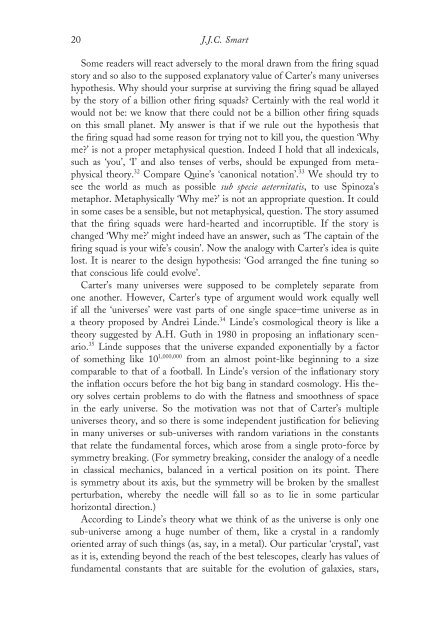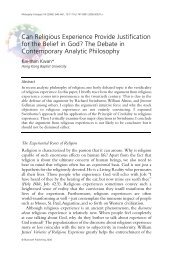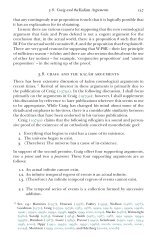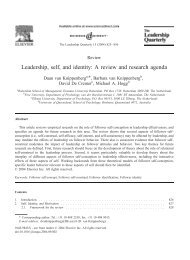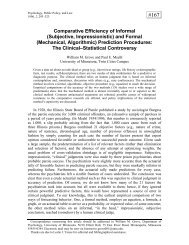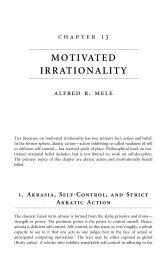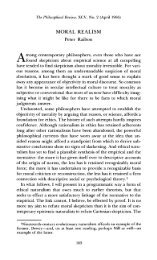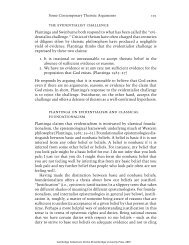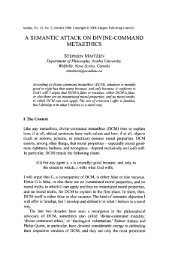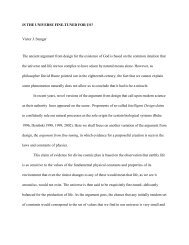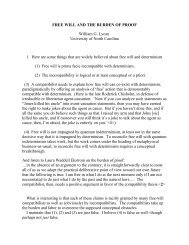Atheism and Theism JJ Haldane - Common Sense Atheism
Atheism and Theism JJ Haldane - Common Sense Atheism
Atheism and Theism JJ Haldane - Common Sense Atheism
Create successful ePaper yourself
Turn your PDF publications into a flip-book with our unique Google optimized e-Paper software.
20 J.J.C. Smart<br />
Some readers will react adversely to the moral drawn from the firing squad<br />
story <strong>and</strong> so also to the supposed explanatory value of Carter’s many universes<br />
hypothesis. Why should your surprise at surviving the firing squad be allayed<br />
by the story of a billion other firing squads? Certainly with the real world it<br />
would not be: we know that there could not be a billion other firing squads<br />
on this small planet. My answer is that if we rule out the hypothesis that<br />
the firing squad had some reason for trying not to kill you, the question ‘Why<br />
me?’ is not a proper metaphysical question. Indeed I hold that all indexicals,<br />
such as ‘you’, ‘I’ <strong>and</strong> also tenses of verbs, should be expunged from metaphysical<br />
theory. 32 Compare Quine’s ‘canonical notation’. 33 We should try to<br />
see the world as much as possible sub specie aeternitatis, to use Spinoza’s<br />
metaphor. Metaphysically ‘Why me?’ is not an appropriate question. It could<br />
in some cases be a sensible, but not metaphysical, question. The story assumed<br />
that the firing squads were hard-hearted <strong>and</strong> incorruptible. If the story is<br />
changed ‘Why me?’ might indeed have an answer, such as ‘The captain of the<br />
firing squad is your wife’s cousin’. Now the analogy with Carter’s idea is quite<br />
lost. It is nearer to the design hypothesis: ‘God arranged the fine tuning so<br />
that conscious life could evolve’.<br />
Carter’s many universes were supposed to be completely separate from<br />
one another. However, Carter’s type of argument would work equally well<br />
if all the ‘universes’ were vast parts of one single space–time universe as in<br />
a theory proposed by Andrei Linde. 34 Linde’s cosmological theory is like a<br />
theory suggested by A.H. Guth in 1980 in proposing an inflationary scenario.<br />
35 Linde supposes that the universe exp<strong>and</strong>ed exponentially by a factor<br />
of something like 10 1,000,000 from an almost point-like beginning to a size<br />
comparable to that of a football. In Linde’s version of the inflationary story<br />
the inflation occurs before the hot big bang in st<strong>and</strong>ard cosmology. His theory<br />
solves certain problems to do with the flatness <strong>and</strong> smoothness of space<br />
in the early universe. So the motivation was not that of Carter’s multiple<br />
universes theory, <strong>and</strong> so there is some independent justification for believing<br />
in many universes or sub-universes with r<strong>and</strong>om variations in the constants<br />
that relate the fundamental forces, which arose from a single proto-force by<br />
symmetry breaking. (For symmetry breaking, consider the analogy of a needle<br />
in classical mechanics, balanced in a vertical position on its point. There<br />
is symmetry about its axis, but the symmetry will be broken by the smallest<br />
perturbation, whereby the needle will fall so as to lie in some particular<br />
horizontal direction.)<br />
According to Linde’s theory what we think of as the universe is only one<br />
sub-universe among a huge number of them, like a crystal in a r<strong>and</strong>omly<br />
oriented array of such things (as, say, in a metal). Our particular ‘crystal’, vast<br />
as it is, extending beyond the reach of the best telescopes, clearly has values of<br />
fundamental constants that are suitable for the evolution of galaxies, stars,


